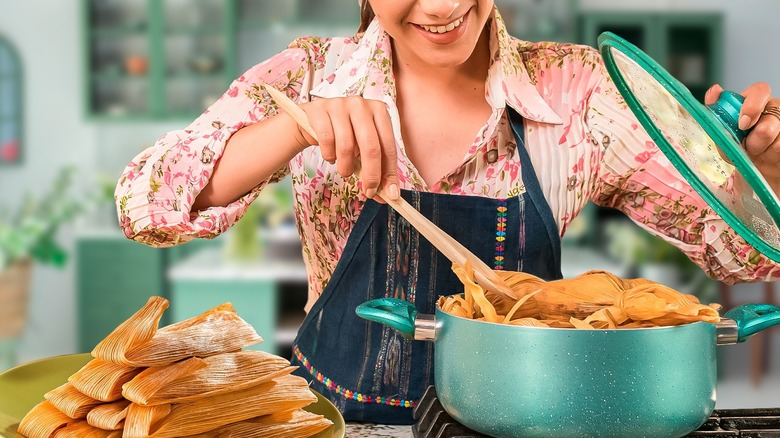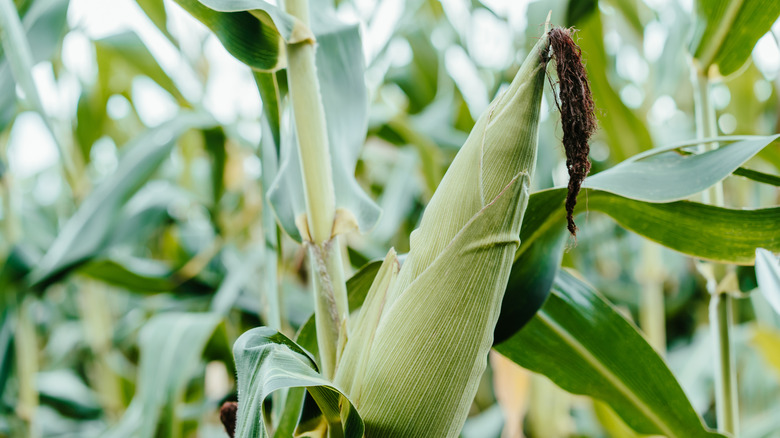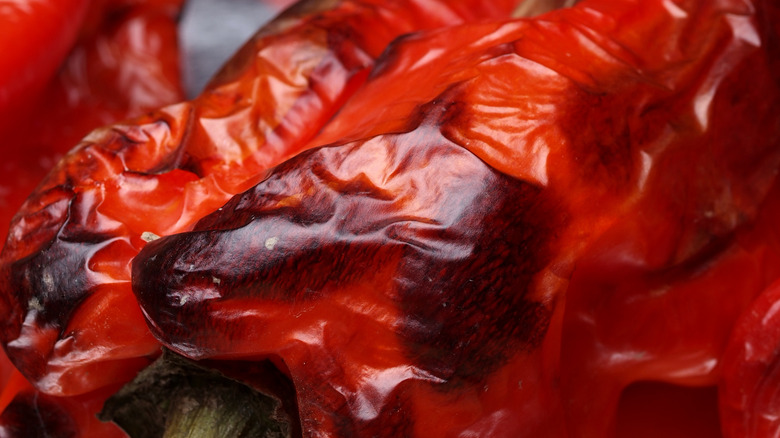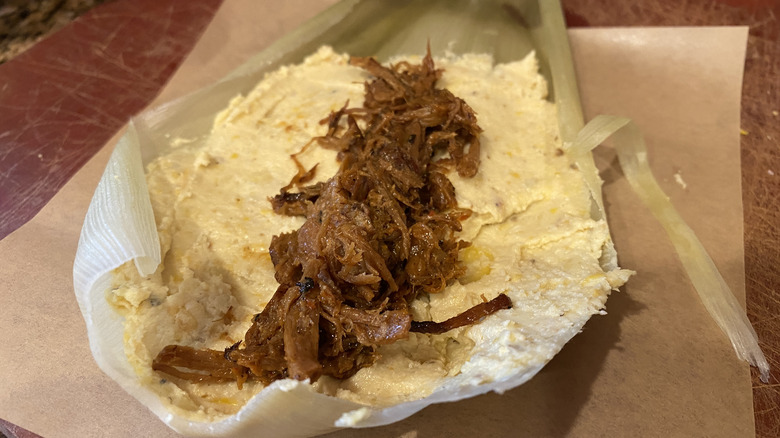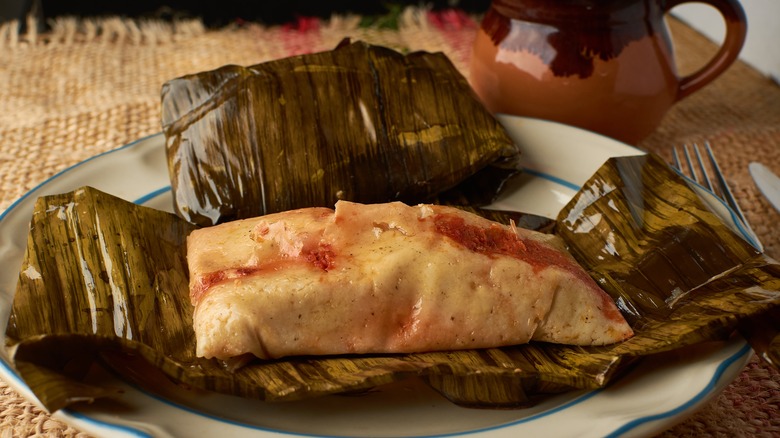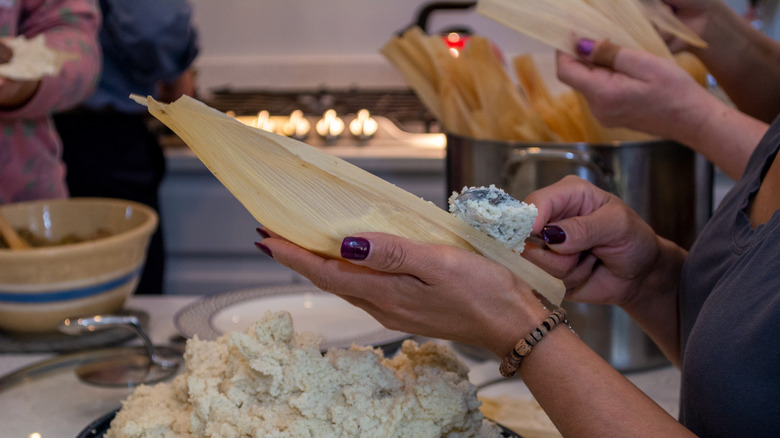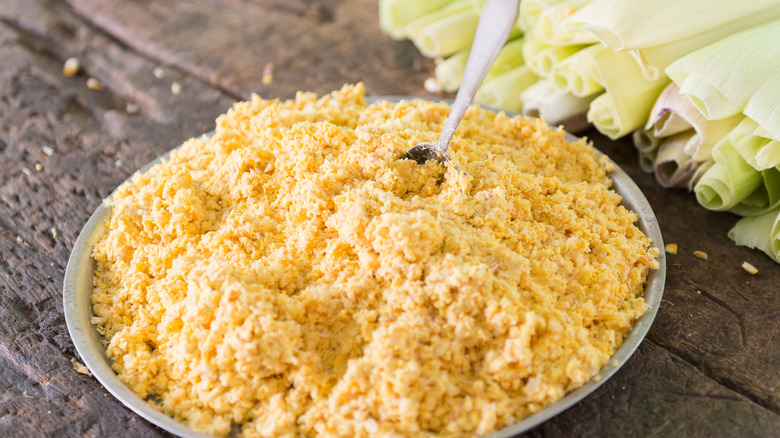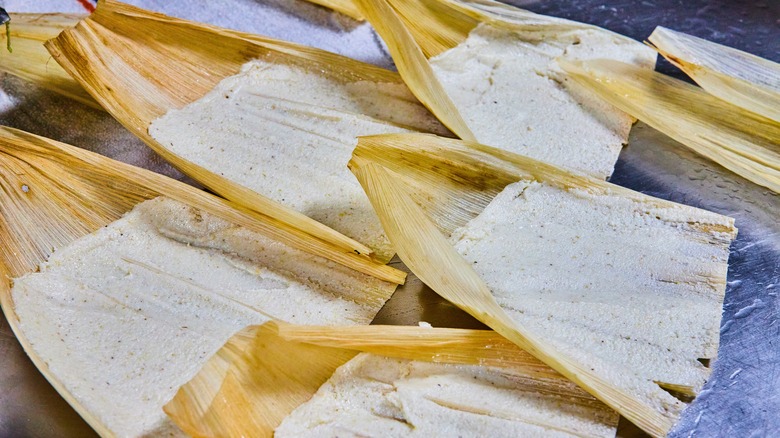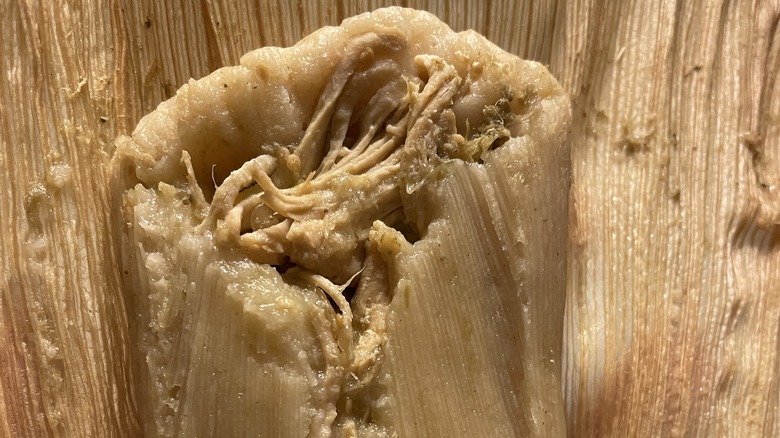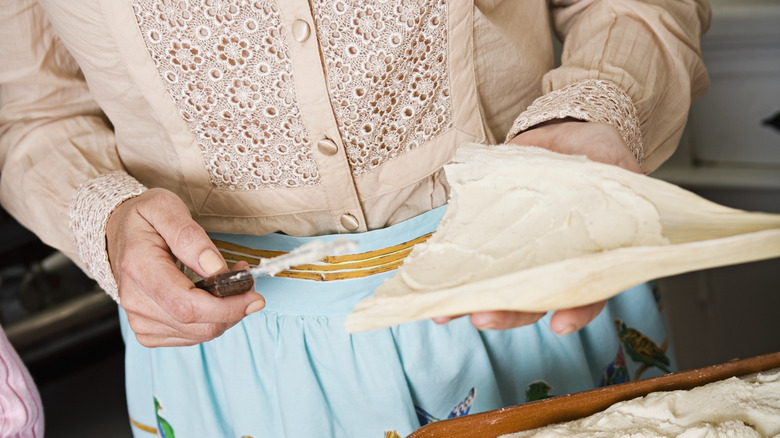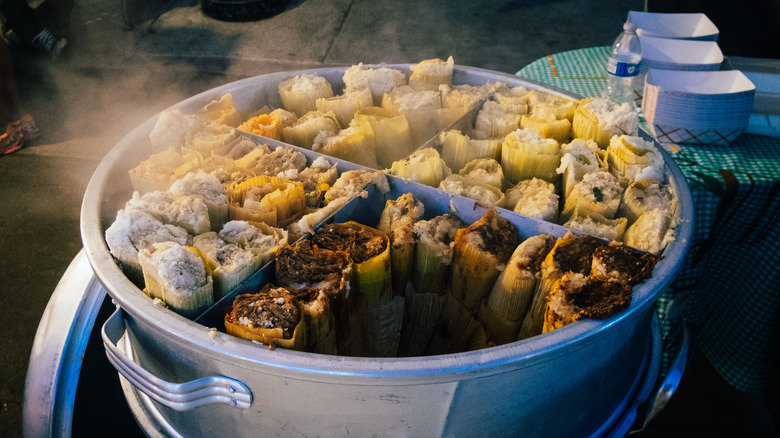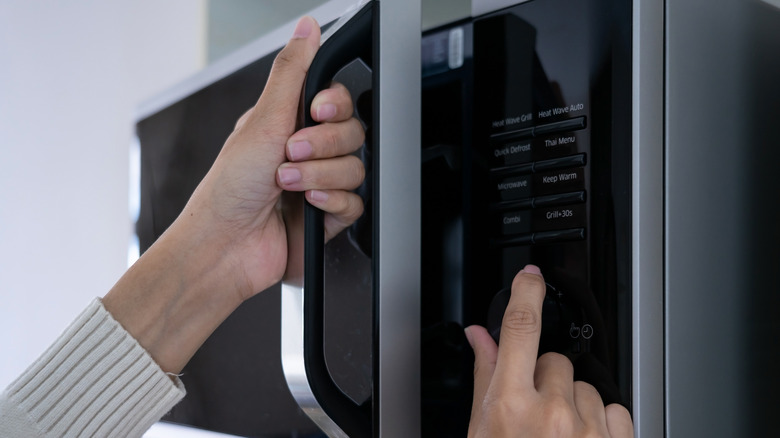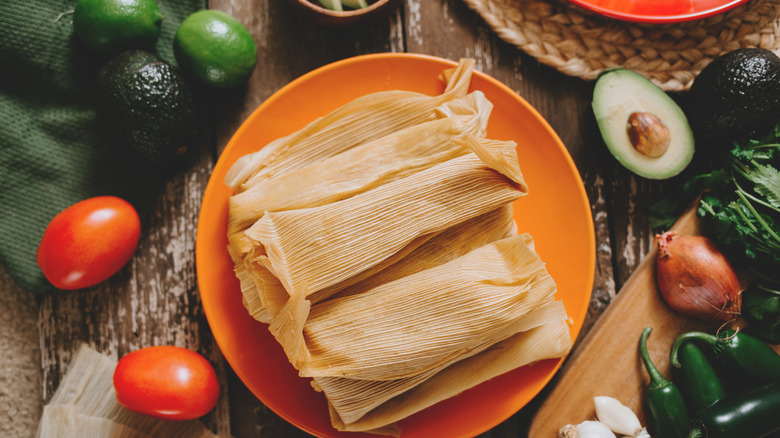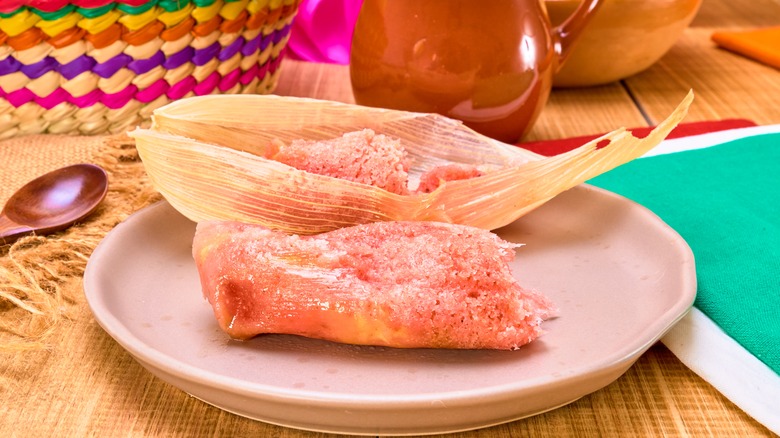14 Tips You Need To Make The Best Tamales
Tamales are a bit of a culinary mystery for anyone who doesn't have a background in Mexican or Latin American cuisine. It's the kind of food you get as a gift for a special occasion once and think to yourself, "Oh yeah, maybe I can make these at home." It's precisely how I started making my own tamales at home every Christmas — made vegan, of course, with a filling of black beans and soy chorizo. Over the years, I've gone through my fair share of overcooked batches, dry corn husks, and overfilled wraps. After all, there is a reason why tamales are reserved for special occasions and holidays.
Although tamale novices may not want to hear it, we can't stress enough that tamales aren't for the faint of heart. You're not going to make one single tamale or even enough for a family of four; many recipes make upwards of 100 tamales that are designed to be made with help from the entire family. The proper preparation of these wraps can take several hours, but the payoff comes with delicious, freezer-friendly meals that are made with love. Here are some of our tried and true tricks for making tamales at home.
Dry your own corn husks for tamales
The key ingredient for a tamale is a corn husk. Although some tamale recipes will use plantain leaves instead, like Guatemalan and Costa Rican tamales, corn husks remain a staple ingredient for widely popularized Mexican tamales. And no, you don't eat the corn husk in any tamales recipe.
You have to use dried corn husks for your tamales, which can be purchased from an ethnic store or online retailer. If you want to take it up a notch, though, you can dry out fresh corn husks using natural sunlight or in your oven. If you're letting nature do its job, place your pre-soaked fresh corn husks in a cardboard box and allow them to dry for several days (or weeks) until crisp to the touch. You can also put them on a baking sheet in your oven and dry them out on low heat for up to eight hours.
Roast your veggies before adding them to the tamales
The biggest qualm many people have with tamales is that the ingredients are all mixed together. After all, it's likely to occur, considering your fillings have to steam with the masa. We recommend integrating new textures, such as roasted or charred veggies, into your tamale to avoid a soggy, claggy filling. Our recipe for tamales da rajas, a vegetarian tamale with poblano peppers, tomatillos, and cheese, calls for the veggies to be roasted before being added to the center of the masa-adorned corn husk. This adds a slight charred flavor to the tamale and gives it a bright bite of texture.
Moreover, the cooking process also helps soften up the filling ingredients before they are pressed into the tamale. If you added raw veggies, particularly crunchy ones like peppers, they wouldn't be able to soften enough. Thus, you'd end up with raw peppers but fully cooked masa.
Always pre-cook your meat for tamales
Just as you'd want to be sure that your veggies are pre-cooked for your tamales, you're also going to want to ensure that your meat is fully cooked before it's wrapped into its masa blanket. This reduces the food safety risk of undercooked meat and ensures your protein is the perfect texture for your tamale.
The type of meat you use for your tamales is up to your discretion (and your tastebuds). For example, Mashed's recipe for Mexican tamales calls for pork shoulder to be cooked with chopped onions, minced garlic, and blended chili peppers for upwards of three hours. It's common for these tamale recipes to include tough cuts of meat that take a while to cook, so be sure to allocate enough time to cook your fillings before you get ready to assemble your tamales. Besides pork, you'll also find shredded chicken as a popular protein for this meal.
Add the cooking liquid back to your tamales to keep them moist
Don't fall into the trap of dry, dense tamales. If you're finding that your tamales are constantly coming out claggy and dense, you might need to reconsider what you're filling them with. If you're cooking with meat, we recommend always incorporating that cooking liquid back into the tamale before you wrap it up. But instead of just adding that juice back to the meat before stuffing the wrapper, try adding that liquid into the masa dough.
If you're finding that your masa dough is too dense and dry — or you cannot easily spread it with an offset spatula without it coming back at you — you can add the cooking liquid or a splash of stock to your masa and mix it again. We find that using the cooking liquid or stock helps bolster the flavor of the masa more than water and adds a more savory flavor.
Soak your corn husks well before assembling
One of the most common mistakes we've experienced with making tamales is having corn husks that are not soft enough to maneuver, fold, and seal. In order to have a husk that doesn't split and can be easily sealed together, you'll need to make sure to fully submerge your corn husks before you start filling and wrapping. Not only that, but you should also rinse and rub off any dirt that may be hidden on the husk before you start filling.
When your husks are clean, submerge them in water for about an hour before you plan to start assembling. We recommend using a wide bowl and a weight to submerge the wraps. You can also shorten the time by using warm water instead of cold; this will reduce your soak time to about 15 minutes. Your husks and the stringy pieces you plan to tie the tamales together should be pliable and able to fold without breaking.
Season your masa
Masa is a standard ingredient for making tamales. The masa lacks flavor, so we recommend taking it to your spice cabinet to up the ante of your dough. A blend of warming spices like paprika, cumin, ancho chili powder, and alike will boost the flavor of your dough and complement any vegetarian or meat-based filling. Other recipes will call for chili-infused masa, which requires the cook to prepare a batch of chilis, blend it into a smooth sauce, and integrate it into the masa dough. This must be done with extreme care, though, as it can dramatically shift the flavor of the masa to something much too spicy for the filling at hand. And if the eaters at your table aren't used to chili, they may be overwhelmed by a spicy filling and masa.
One ingredient that is often disputed around tamales is baking powder. We've found that this ingredient makes the masa filling much more soft and pliable than recipes without it, but some tamale makers will refuse to touch the leavener with a 10-foot pole. We think that this addition is up to your comfort level, as well as how accepting you are of straying from tradition.
Use masa harina as your filling base
There are a few different options for sourcing masa for your tamales. You can buy pre-made masa dough (with the perfect consistency for tamales) at some ethnic grocery stores. But if you can't source this product, you can use masa harina in place of masa. Masa harina is a widely available dried flour found in the Latin American section of most major grocery stores. It's the same ingredient you would use to make homemade corn tortillas, but in this case, the tamales are bound together with a fat in addition to just water.
You'll need 3 cups of masa, 2¼ cups of water or broth, and 1¼ cups of liquid fat for the perfect masa consistency. From there, you can tweak your recipe with seasonings, salt, and baking powder to get the ideal masa consistency. Just be sure to use masa harina — not just any plain flour — for your filling.
Don't neglect the lard
Fat is the critical ingredient that separates the masa inside of a tamale from the ingredients used for a tortilla. The secret to getting a soft, plush filling that pulls away from the sides of the corn husk as it cooks is always using a fat. Traditionally, these tamales are made with pork lard or vegetable shortening, but some modern recipes have also substituted canola or vegetable oil. You should never touch olive oil for this recipe, though, because its grassy flavor conflicts with the others in the tamales. Alternate adding the fat and the water (or broth) to your masa dough to get the perfect consistency.
One unlikely ingredient that we've also used as a fat replacement in our oil-free tamales is puréed canned corn. We add a can of this corn to our blender with a splash of broth until it's smooth before adding it to the corn flour and the broth. This mixture is corn-forward in flavor, but it also has the tackiness that replaces the feeling of the fat.
Keep the amount of masa in each consistent
Consistency is the key to making a great batch of tamales. Your masa mixture is ready to go once it has a consistency similar to pancake batter. Or, test your masa by dropping a small portion into a cup of cold water. If your masa floats, it's the perfect consistency. If not, knead it for a few more minutes and test it again.
Then comes the time to add the masa to the husks. The key to this is to be conservative with your masa; you'll only need about ¼ cup of masa for each tamale and a little less if the husks run small. Place the masa in the center of the tortilla and spread upwards to the wide edge of the husk, leaving an inch-or-so border on all sides of the husk. If you push the masa too far to the edge, you'll risk the masa coming out as the tamale cooks. The secret to wrapping tamales is to also only use about two tablespoons of filling in each tamale since they're super easy to overstuff.
Use the coin trick to determine when to add more water to the steamer
Tamales are steamed to perfection, which gives them their soft texture and creamy filling. To ensure that your tamales come out with the perfect consistency and to ensure that you can fit all of your tamales into a single pot, we recommend propping each up vertically, tightly next to the others, in a bouquet-style shape. If you placed your tamales horizontally in the basket, they would squish one another and prevent the steam from getting into all the crevasses of the husk.
You should also constantly check to ensure your tamales are getting enough steam. Depending on the size of your pot, this may require you to refill the water on the bottom constantly. One trick to knowing when to refill your pot is putting a coin in the bottom with the water. The boiling water will cause the coin to rattle, but when the noise stops, you'll know there's not enough water to steam the tamales.
Check to see if they are finished cooking before removing them from the steamer
There's nothing worse than biting into raw masa filling. Tamales are so difficult to perfect at home because there is a thin line between a tamale that is overcooked and dry and one that is just not there yet. Always keep the steamer over medium heat, and avoid packing the tamales too tight in the basket.
When you think your tamales are finished cooking, sacrifice a few from your basket. The key is to choose at least two tamales, one from the center of your basket and the other from the outside ring, to limit the variability in cooking time. A perfectly cooked tamale will lift away from the corn husk with ease, while one that is undercooked will stick like glue to the husk. It's important always to use this method to check your tamales rather than rely on the cooking time listed on the recipe because the size of your pot, heat, and how tightly your tamales are packed will all influence the cooking time.
Skip the microwave when it comes time to reheat your tamales
One of the reasons we love tamales is that you can reheat and eat them throughout the week. The absolute best ways to reheat your tamales include a steamer basket, which will bring refrigerated tamales back to life in 20 minutes and frozen ones in 30. Although this method requires more technical equipment (which is bad news for you if you happen to get these tamales as a gift), it will ensure the masa stays plush and soft. You can also wrap the tamales in foil and pop them in your air-fryer or oven.
Although the microwave may be the most convenient, it is not always the best way to reheat your tamales. It sucks the moisture out very quickly, which will leave you with dry masa. Never reheat tamales from frozen in the microwave, and if you have to heat up a refrigerated one, always wrap it in a damp paper towel to lock in the moisture.
Don't neglect your toppings
Tamales are versatile not only in fillings but also in the ingredients you can top them with. We recommend pairing your tamales with something that's fresh and bright to help distract from the denseness of the fillings. A bright pico de gallo or sliced avocado can easily lighten up a dish while a side of Mexican rice seasoned with garlic, chili, cumin, and tomatoes would mesh well with a meat or vegetable filling.
Another star topping for tamales is in the form of sauces. If you want an easy recipe, check out our homemade red enchiladas sauce. While it may not have initially been intended for tamales, the blend of guajillo and ancho chili peppers adds a depth of smokiness and savoriness that will elevate a pork or chicken tamale. You might also go for a light, dairy-based sauce like a crema to help rein in some of the spiciness of the tamale make bring some balance to your plate.
Try a sweet tamales recipe
Although we often think of tamales as savory, there is an opportunity to play with sweet versions of the food as well. Around the holidays, you'll often see tamales dulces, which feature a sugar-sweetened masa filling adorned with raisins, pineapple chunks, shredded coconut, and peanuts. You may also find recipe variations made with chocolate chips, pecans, and dried cherries. These tamales may have a lot going on, but they ensure a bit of variety in every bite.
Another popular sweet variation is tamales de cajeta, which are filled with a brown sugar and milk mixture that closely resembles dulce de leche. The sauce is added to the masa with chopped walnuts before being tucked gently together inside the corn husk. Once these tamales have steamed and cooled, they're topped with extra cajeta and chopped walnuts. It's the perfect after-dinner treat or celebration staple for the holidays.
Static Media owns and operates Tasting Table and Mashed.
